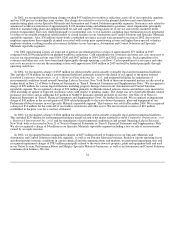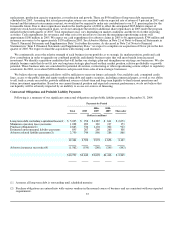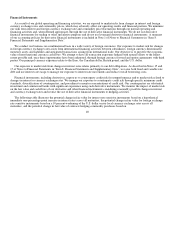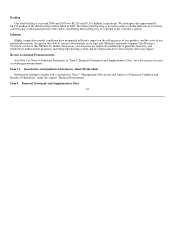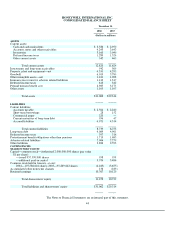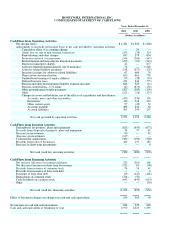Honeywell 2004 Annual Report Download - page 51
Download and view the complete annual report
Please find page 51 of the 2004 Honeywell annual report below. You can navigate through the pages in the report by either clicking on the pages listed below, or by using the keyword search tool below to find specific information within the annual report.
Each of our businesses continues to focus on strategies to improve working capital turnover in 2005 to increase operating cash flows.
Considering the current economic environment in which each of our businesses operate and our business plans and strategies,
including our focus on growth, cost reduction and productivity initiatives, we believe that our cash balances and operating cash flows
will remain our principal source of liquidity. In addition to our available cash and operating cash flows, additional sources of liquidity
include committed credit lines, access to the public debt and equity markets using debt and equity securities, including commercial
paper, as well as our ability to sell trade accounts receivables.
A source of liquidity is our ability to issue short-term debt in the commercial paper market. Our ability to access the commercial
paper market, and the related cost of these borrowings, is affected by the strength of our credit ratings and our $2.3 billion of
committed bank revolving credit facilities (Revolving Credit Facilities). Our credit ratings are periodically reviewed by the major
independent debt-rating agencies. In 2004, Standard and Poor's and Fitch Rating Services affirmed their corporate ratings on our long-
term debt, A and A+, respectively, and short-term debt A-1 and F1, respectively, and revised Honeywell's outlook from “negative” to
“stable”. Moody's Investors Service affirmed its corporate rating on our long-term and short-term debt of A2 and P-1, respectively.
Our credit rating provided by Moody's Investors Service reflects a “negative outlook” due principally to the cyclical market conditions
in the commercial air transport industry, our potential exposure to asbestos liabilities, and the existence of integration risk associated
with our recently announced acquisition of Novar plc (expected to be completed in the first quarter of 2005). The “negative outlook”
has not impaired, nor do we expect it to impair, our access to the commercial paper markets.
Commercial paper notes are sold at a discount and have a maturity of not more than 270 days from date of issuance. Borrowings
under the commercial paper program are available for general corporate purposes as well as for financing potential acquisitions. There
was $220 million of commercial paper outstanding at December 31, 2004.
Our $2.3 billion of Revolving Credit Facilities are maintained with a group of banks, arranged by Citigroup Global Markets Inc.
and J.P. Morgan Securities Inc., and comprises: (a) a $1 billion Five-Year Credit Agreement and (b) a $1.3 billion Five-Year Credit
Agreement. The credit agreements are maintained for general corporate purposes, including support for the issuance of commercial
paper. The $1 billion Five-Year Credit Agreement was put in place on October 22, 2004, replacing a $1 billion 364-Day Credit
Agreement which was expiring on November 24, 2004. This newly established Five-Year credit facility includes a $200 million sub-
limit for the potential issuance of letters of credit. The $1.3 billion Five-Year Credit Agreement was increased in November 2003 with
the addition of a $300 million sub-limit for the potential issuance of letters of credit. See Note 15 of Notes to Financial Statements in
“Item 8. Financial Statements and Supplementary Data.”
We also have a shelf registration statement filed with the Securities and Exchange Commission which allows us to issue up to $3
billion in debt securities, common stock and preferred stock that may be offered in one or more offerings on terms to be determined at
the time of the offering. Net proceeds of any offering would be used for general corporate purposes, including repayment of existing
indebtedness, capital expenditures and acquisitions.
We also sell interests in designated pools of trade accounts receivables to third parties. The sold receivables were over-
collateralized by $120 million at December 31, 2004 and we retain a subordinated interest in the pool of receivables representing that
over-collateralization as well as an undivided interest in the balance of the receivables pools. New receivables are sold under the
agreement as previously sold receivables are collected. The retained interests in the receivables are reflected at the amounts expected
to be collected by us, and such carrying value approximates the fair value of our retained interests. The sold receivables were $500
million at both December 31, 2004 and 2003.
In addition to our normal operating cash requirements, our principal future cash requirements will be to fund capital expenditures,
debt repayments, employee benefit obligations, environmental remediation costs, asbestos claims, severance and exit costs related to
repositioning actions, share repurchases and any strategic acquisitions. Our total capital expenditures in 2005 are currently projected at
approximately $775 million. These expenditures are primarily intended for maintenance,
36







